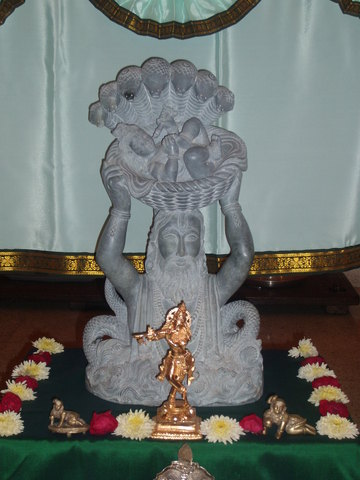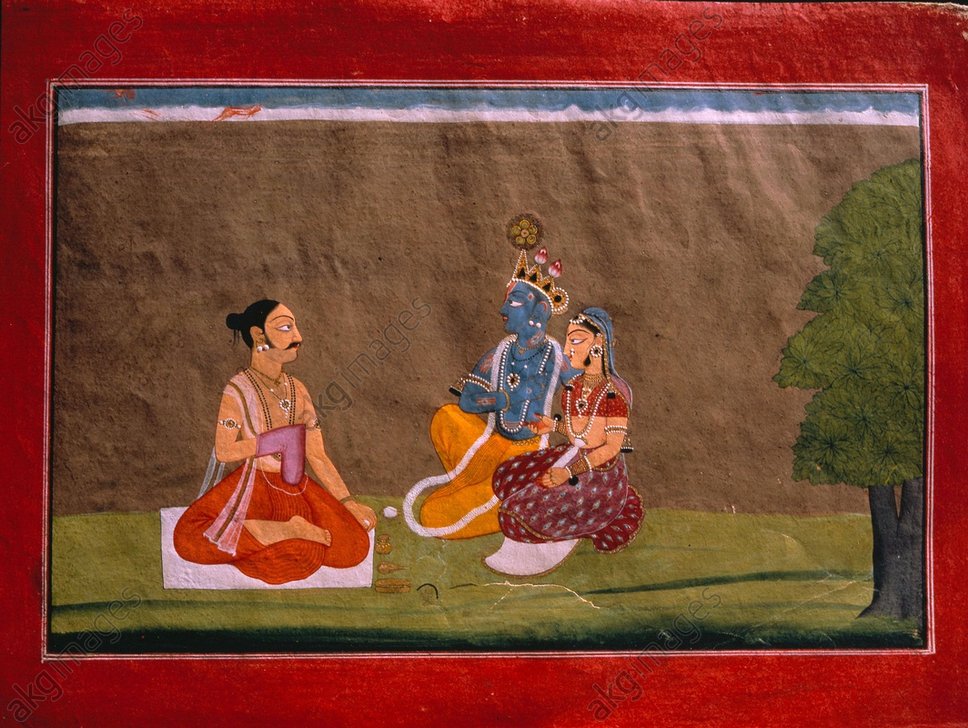|
Rasa (theology)
Rasa (IAST ) refers to the creation and reception of a distinct 'flavor' or quality of something. As a Sanskrit theological concept, rasa was popularized by specific to Krishna-centered bhakti traditions, such as Gaudiya Vaishnavism from the fifteenth century. The theological use of the word can be found early, about two thousand years before the Nimbarka or Chaitanya schools of bhakti, in a phrase that Chaitanya traditions frequently quote: "Truly, the Lord is ''rasa''" (''raso vai sah'') of the Taittiriya Upanishad (2.7.1). This statement expresses the view that God is the one who enjoys the ultimate rasa, or spiritual rapture and emotions. It is believed Rupa Goswami developed, under the direct guidance of Caitanya, the articulated and formulated theology of rasa as "the soul's particular relationship with the divinity in devotional love". Rupa's text draws largely from the foundational theory of rasa formed by Bharata Muni, the originator of Sanskrit dramaturgy, or '' Natya Sa ... [...More Info...] [...Related Items...] OR: [Wikipedia] [Google] [Baidu] |
IAST
The International Alphabet of Sanskrit Transliteration (IAST) is a transliteration scheme that allows the lossless romanisation of Indic scripts as employed by Sanskrit and related Indic languages. It is based on a scheme that emerged during the nineteenth century from suggestions by Charles Trevelyan, William Jones, Monier Monier-Williams and other scholars, and formalised by the Transliteration Committee of the Geneva Oriental Congress, in September 1894. IAST makes it possible for the reader to read the Indic text unambiguously, exactly as if it were in the original Indic script. It is this faithfulness to the original scripts that accounts for its continuing popularity amongst scholars. Usage Scholars commonly use IAST in publications that cite textual material in Sanskrit, Pāḷi and other classical Indian languages. IAST is also used for major e-text repositories such as SARIT, Muktabodha, GRETIL, and sanskritdocuments.org. The IAST scheme represents more than a ... [...More Info...] [...Related Items...] OR: [Wikipedia] [Google] [Baidu] |
Rasa Lila
The rasalila (), also rendered the raslila or the ras dance, is part of the traditional story of Krishna described in Hindu scriptures such as the Bhagavata Purana and literature such as the Gita Govinda, where he dances with Radha and the gopis of Vraja. Rasalila has also been a popular theme for other India classical dances including Bharatanatyam, Odissi, Manipuri, Kuchipudi, and Kathak. The Indian classical dance of Kathak evolved from the rasalila of Vraja and ''Manipuri Raas Leela Classical Dance'' (Vrindavana) also known as ''Natwari Nritya'', which was revived in 1960s by the Kathak dancer, Uma Sharma. Etymology The term, '' rasa'' meaning "aesthetics" and ''lila'' meaning "act," "play" or "dance" is a concept from Hinduism, which roughly translates to "play (lila) of aesthetics (rasa)," or more broadly as "Dance of Divine Love". Apart from the definition above, the term also comes from the Sanskrit words '' rasa'' and ''lila'', with ''rasa'' meaning "juice", "nectar", ... [...More Info...] [...Related Items...] OR: [Wikipedia] [Google] [Baidu] |
Sringara
Sringara ( sa, शृङ्गार, ) is one of the nine rasas, usually translated as erotic love, romantic love, or as attraction or beauty. ''Rasa'' means "flavour", and the theory of rasa is the primary concept behind classical Indian arts including theatre, music, dance, poetry, and sculpture. Much of the content of traditional Indian arts revolves around the relationship between a man and a woman. The primary emotion thus generated is Sringara. The romantic relationship between lover and beloved is a metaphor for the relationship between the individual and the divine. Classical theater/dancers (i.e. Bharatanatyam, Odissi, Mohiniyattam) refer to Sringara as 'the Mother of all rasas.' Sringara gives scope for a myriad of other emotions including jealousy, fear, anger, compassion, and of course for the expression of physical intimacy. No other Rasa has such a vast scope. The treatment and performance of Sringara varies on a large scale from the grotesque (as in Koodiyattam) to ... [...More Info...] [...Related Items...] OR: [Wikipedia] [Google] [Baidu] |
Radha Krishna
Radha-Krishna (IAST , sa, राधा कृष्ण) are collectively known within Hinduism as the combined forms of feminine as well as the masculine realities of God. Krishna and Radha are the primeval forms of God and his pleasure potency (Hladini Shakti), respectively, in several Vaishnavism, Vaishnavite schools of thought. In Krishnaism, Krishnaite traditions of Vaishnavism, Krishna is referred to as ''Svayam Bhagavan'' and Radha is illustrated as the primeval potency of the three main potencies of God, ''Hladini (immense spiritual bliss), Sandhini (eternality) and Samvit (existential consciousness)'' of which Radha is an embodiment of the feeling of love towards the almighty Lord Krishna (''Hladini''). With Krishna, Radha is acknowledged as the Supreme Goddess. It is said that Krishna is only satiated by devotional service in loving servitude and Radha is the personification of devotional service to the supreme lord. Various devotees worship her with the understandin ... [...More Info...] [...Related Items...] OR: [Wikipedia] [Google] [Baidu] |
Bhakti Yoga
Bhakti yoga ( sa, भक्ति योग), also called Bhakti marga (, literally the path of ''Bhakti''), is a spiritual path or spiritual practice within Hinduism focused on loving devotion towards any personal deity.Karen Pechelis (2014), The Embodiment of Bhakti, Oxford University Press, , pages 19-24 It is one of the three classical paths in Hinduism which lead to ''Moksha'', the other paths being Jnana yoga and Karma yoga. The tradition has ancient roots. Bhakti is mentioned in the '' Shvetashvatara Upanishad'' where it simply means participation, devotion and love for any endeavor. ''Bhakti yoga'' as one of three spiritual paths for salvation is discussed in depth by the ''Bhagavad Gita''. The personal god varies with the devotee.Bhakti Encyclopedia Britannica (2009)Karen Pechelis (2011), Bhak ... [...More Info...] [...Related Items...] OR: [Wikipedia] [Google] [Baidu] |
Swami B
Swami ( ; sometimes abbreviated sw.) in Hinduism is an honorific title given to a male or female ascetic who has chosen the path of renunciation (''sanyāsa''), or has been initiated into a religious monastic order of Vaishnavas. It is used either before or after the subject's name (usually an adopted religious name). The meaning of the Sanskrit root of the word ''swami'' is " e who isone with his self" ( stands for "self"), and can roughly be translated as "he/she who knows and is master of himself/herself". The term is often attributed to someone who has achieved mastery of a particular yogic system or demonstrated profound devotion ('' bhakti'') to one or more Hindu gods. The ''Oxford English Dictionary'' gives the etymology as: As a direct form of address, or as a stand-in for a swami's name, it is often rendered ''Swamiji'' (also ''Swami-ji'' or ''Swami Ji''). In modern Gaudiya Vaishnavism, ''Swami'' is also one of the 108 names for a sannyasi given in Bhaktisiddhanta ... [...More Info...] [...Related Items...] OR: [Wikipedia] [Google] [Baidu] |
Bhajan
Bhajan refers to any devotional song with a religious theme or spiritual ideas, specifically among Indian religions, in any language. The term bhajanam (Sanskrit: भजनम्) means ''reverence'' and originates from the root word ''bhaj'' (Sanskrit: भज्), which means ''to revere'', as in 'Bhaja Govindam' (''Revere Govinda'')''. ''The term bhajana also means ''sharing''. The term 'bhajan' is also commonly used to refer a group event, with one or more lead singers, accompanied with music, and sometimes dancing. Normally, bhajans are accompanied by percussion instruments such as ''tabla'', dholak or a tambourine. Handheld small cymbals (''kartals'') are also commonly used to maintain the beat. A bhajan may be sung in a temple, in a home, under a tree in the open, near a river bank or a place of historic significance.Anna King, John Brockington, ''The Intimate Other: Love Divine in Indic Religions'', Orient Longman 2005, p 179. Having no prescribed form, or set rules, ... [...More Info...] [...Related Items...] OR: [Wikipedia] [Google] [Baidu] |
Krishna Janmashtami
Krishna Janmashtami , also known simply as Krishnashtami, Janmashtami, or Gokulashtami, is an annual Hindu festival that celebrates the birth of Krishna, the eighth avatar of Vishnu. According to the Hindu lunisolar calendar, it is observed on the eighth tithi (Ashtami) of the Krishna Paksha (dark fortnight) of Shraavana Masa (according to the amanta tradition) or Bhadrapada Masa (according to the purnimanta tradition). This overlaps with August or September of the Gregorian calendar. It is an important festival, particularly in the Vaishnavism tradition of Hinduism. Dance-drama enactments of the life of Krishna according to the ''Bhagavata Purana'' (such as Rasa Lila or Krishna Lila), devotional singing through the midnight when Krishna was born, fasting (''upavasa''), a night vigil (Ratri ''Jagaran''), and a festival (Mahotsav) on the following day are a part of the Janmashtami celebrations. It is celebrated particularly in Mathura and Vrindavan, along with major Vaishn ... [...More Info...] [...Related Items...] OR: [Wikipedia] [Google] [Baidu] |
Bhagya Chandra
Ningthou Ching-Thang Khomba (also Rajarshi Bhagya Chandra, Jai Singh Maharaja) (1748–1799) was a Meitei monarch of the 18th century CE. The inventor of the Manipuri Raas Leela dance, with his daughter ''Shija Lailoibi'' playing as Radha at the first performance, he is a popular figure in Manipur, and much of his actions as King had been mythologized. He is also credited with spreading Vaishnavism in Manipur State after his grandfather Pamheiba made Hinduism the official religion and for creating a unified Manipur. Early years Maharaja Bhagya Chandra ascended to the throne of Manipur in 1759, a few years after the death of his grandfather Pamheiba and his father Samjai Khurai-Lakpa at the hands of his uncle Chitsai. In 1762, Manipur was attacked by the Burmese, assisted by the Chitsai. He, along with the Rani (Queen) and a few loyal attendants fled to Ahom (modern-day Assam), where they lived under the protection of the Ahom ruler, Rajeswar Singha. Life in Assam Bhagya ... [...More Info...] [...Related Items...] OR: [Wikipedia] [Google] [Baidu] |
Radha
Radha ( sa, राधा, ), also called Radhika, is a Hindu goddess and the chief consort of the god Krishna. She is worshiped as the goddess of love, tenderness, compassion, and devotion. She is the avatar of goddess Lakshmi and is also described as the chief of the ''Gopis'' (milkmaids). During Krishna's youth, she appears as his lover and companion. Many traditions and scriptures accord Radha the status of the eternal consort and wife of Krishna. Radha, as a supreme goddess, is considered as the female counterpart and the internal potency (''hladini shakti'') of Krishna, who resides in Goloka, the celestial abode of Radha Krishna. Radha is said to accompany Krishna in all his incarnations. In Radha Vallabh Sampradaya and Haridasi Sampradaya, only Radha is worshiped as the supreme deity. Elsewhere, she is venerated with Krishna as his principal consort in Nimbarka Sampradaya, Pushtimarg, Mahanam Sampraday, Swaminarayan Sampradaya, Vaishnava-Sahajiya and Gaudiya Vaishnavis ... [...More Info...] [...Related Items...] OR: [Wikipedia] [Google] [Baidu] |


_Hindu_in_midst_of_puja_in_Himachal_Pradesh_India.jpg)


